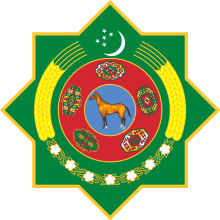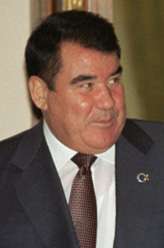President of Turkmenistan
The president of Turkmenistan (Turkmen:Türkmenistanyň prezidenti) is the head of state and of the executive power, is the highest official of Turkmenistan, and has the constitutional charter to act as a guarantor of national independence, territorial integrity, and adherence to the Constitution and international agreements.[3]
| President of Turkmenistan Türkmenistanyň prezidenti | |
|---|---|
 Coat of Arms of Turkmenistan | |
 Standard of the President of Turkmenistan | |
| Style | His Excellency (international correspondence) Mr. President (informally) Distinguished Supreme Commander-in-Chief (military) Arkadag (used to address Gurbanguly Berdimuhamedow) Turkmenbasy (used during rule of President Niyazov) |
| Member of | Cabinet of Ministers State Security Council |
| Residence | Oguzkhan Presidential Palace |
| Seat | Ashgabat |
| Appointer | Direct popular vote |
| Term length | 7 years, renewable |
| Inaugural holder | Saparmurat Niyazov |
| Formation | 2 November 1990 (Turkmen SSR) 27 October 1991 (Turkmenistan) |
| Succession | Chairman of the Assembly of Turkmenistan |
| Deputy | Vice President of Turkmenistan |
| Salary | 10,800 USD annually[2] |
Gurbanguly Berdimuhamedow is the current president of Turkmenistan, only the second in the history of the country since it gained independence with the dissolution of the Soviet Union in 1991. He succeeded Turkmenistan's first president for life, Saparmurat Niyazov, when Niyazov died in 2006 after a reign of 15 years. In the 2017 election Berdimuhamedow received 98% of the country's popular vote against eight other candidates, and has now reigned for over 13 years. The country passed reforms in 2016 eliminating term limits for the presidency and removing the previous age requirement of below 70, as well as extending the term from five to seven years.[4] The President is also the supreme commander of the Armed Forces of Turkmenistan and the chairman of the country's Cabinet of Ministers.
Requirements for presidents and removal from office
Requirements for candidates for president of Turkmenistan include the following:[5]
- Must have been born in Turkmenistan
- Must be fluent in the Turkmen language
- Must be at least 40 years old
- Must have resided in Turkmenistan for the past 15 consecutive years
- Must be employed
The powers of the president of Turkmenistan may be terminated in accordance with article 57 of the Turkmen constitution in the event of:
- Inability to perform their duties due to illness
- Violation of the constitution and public laws
- A vote of no confidence in the president
Should the president be removed from office, the chairman of the Assembly is legally appointed as acting president, with elections being held no later than 60 days after the fact. This has never taken place; in 2006, when Turkmenistan's only presidential vacancy occurred due to Niyazov's death in office, the State Security Council of Turkmenistan transferred the right to act as President to the first deputy chairman of the Cabinet of Ministers on an ad-hoc basis. The requirement that an acting president does not have the right to run for president was also dropped.
Residence
The Oguzkhan Presidential Palace is the principal residence/workplace of the president, located on Independence Square in Ashgabat. The various halls of the palace are used to receive foreign leaders and sign presidential decrees. Former president Saparmurat Niyazov owned a private residence in official residence in Arshabil, a town 28 kilometers outside of Ashgabat.[6]
Transport and security
The president of Turkmenistan utilizes a specially made Boeing 777-200LR, painted in the national colors, during international and regional visits. These planes are provided by Turkmenistan Airlines. The president employs a Mercedes-Benz S-Class vehicle to transport him/her throughout the capital city. On some occasions, the vehicle is escorted by a mounted troop from the armed forces. The president also utilizes trains to transport them from one place to another.
.jpg)
The Presidential Security Service (Prezidentiniň howpsuzlyk gullugy) is responsible for ensuring the protection and security of the president. Established in November 1990, it is an directly reporting body of the President of Turkmenistan. In the early 1990s, the Presidential Security Service was removed from the National Security Committee and transformed into an independent body. On September 23, 1994, the Law of Turkmenistan "On the operative-search activity" came into force, according to which one of the main tasks of the service is to ensure the security of the President of Turkmenistan.[7] During state visits to foreign countries, the service provides at least 10 agents to protect the president.[8] The Presidential Security Service is organized in the following way:
- Secretariat
- Duty Division
- 1st Division (Personal guard of the president)
- 2nd Division
- 3rd Division
- 4th Division
- Special Operations Regiment
- 1st Battalion
- 2nd Battalion
- 3rd Battalion
The Presidential Security Service is currently composed of 2,000 employees.[9]
Heads of the Security Service
| No | Name | Appointed | Dismissed |
| 1 | Akmurad Rejepov | 1990 | 15 May 2007 |
| 2 | Charymurad Amanov | 15 May 2007 | 25 January 2008 |
| 3 | Guycheldy Khojaberdiyev | 25 January 2008 | 5 October 2014 |
After the dismissal of Khojaberdiyev, the appointment of a new chief was not reported.
List of presidents of Turkmenistan
| No. | Name
(birth and death) |
Portrait | Took office | Left office | Political party |
|---|---|---|---|---|---|
| 1 | Saparmurat Niyazov (1940–2006) |
 |
2 November 1990 | 21 December 2006
(Died in office) |
Communist Party of Turkmenistan |
| 2 | Gurbanguly Berdimuhamedow (1957–) |
_02.jpg) |
21 December 2006 | Present | Democratic Party of Turkmenistan Independent |
 |
|---|
| This article is part of a series on the politics and government of Turkmenistan |
|
Rank by time in office
| Rank | President | Time in office | |
|---|---|---|---|
| 1 | Saparmurat Niyazov | 15 years, 55 days[10] | |
| 2 | Gurbanguly Berdimuhamedow | 13 years, 123 days | 13 years, 178 days |
| — | Gurbanguly Berdimuhamedow | 55 days (Acting) | |
See also
References
- Acting between 21 December 2006 and 14 February 2007.
- "Зарплата для избранных". www.kommersant.ru. 9 October 2006.
- Article 50 of the Constitution of Turkmenistan.
- "The president of Turkmenistan wins re-election with 98% of the vote". The Economist. Retrieved 2017-02-26.
- Конституция Туркмении
- Hiro, Dilip (November 2011). Inside Central Asia: A Political and Cultural History of Uzbekistan, Turkmenistan, Kazakhstan, Kyrgyz stan, Tajikistan, Turkey, and Iran. ISBN 9781590203781.
- http://base.spinform.ru/show_doc.fwx?rgn=2421
- https://pikabu.ru/story/koechto_o_prezidentskoy_okhrane_5967301
- https://en.hronikatm.com/2013/06/some-facts-about-the-presidential-security-team/
- Counting from the declaration of independence on 27 October 1991.